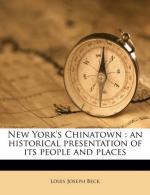|
This section contains 1,518 words (approx. 6 pages at 300 words per page) |

|
Tang Stone Sculpture. The great economic power and social stability of the Tang dynasty (618-907) provided the necessary environment, manpower, and financing for the creation of large-scale stone carvings and sculptures, including those at the Mogao (Highest) Caves of Dunhuang in Gansu Province, the Longmen (Dragon Gate) Cave in Henan Province, the Tianlongshan (Mountain of the Heavenly Dragon) in Shanxi Province, the cave temple of Binglin near Lanzhou in Gansu Province, and the Qianling tomb in Qianxian County of Shanxi Province. Unlike Buddhist stone sculptures of earlier eras, Tang Buddhist figures are secular, emotional, and possessed of humanized characteristics. For instance, the large Buddha in the Mogao Caves has a full, round face, smiling and widespaced eyes, thick lips, and a kindly and affable expression, while in earlier Buddhist sculptures his facial expression is majestic, solemn, and awe inspiring. In addition to the large Buddha...
|
This section contains 1,518 words (approx. 6 pages at 300 words per page) |

|




